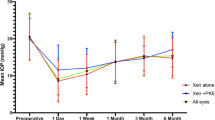Abstract
Purpose
Cataract surgery has been reported to adversely affect the IOP control in eyes with the glaucoma drainage implant (GDI). One reason might be the flow of lens debris/viscoelastic material through the GDI tube into the bleb. This pilot study was conducted to determine the clinical results of a novel technique for temporary occlusion of the GDI tube with an iris retractor hook during phacoemulsification.
Methods
Retrospective analysis of 15 patients (control group) who underwent phacoemulsification between January 2005 and December 2010 and 17 patients (treatment group) who underwent phacoemulsification with the hooked tube technique between January 2011 and April 2016 with a minimum 1-year follow-up.
Results
The IOP remained within 4 mmHg of the preoperative level in all eyes of the treatment group. Three eyes exhibited IOP spikes (≥ 10 mmHg) among controls. The mean postoperative IOP at 1 month was statistically significantly increased in the control group compared with the treatment group (P = 0.040). The number of antiglaucoma medications at 3 and 6 months was significantly increased in the control group (1.4 ± 1.1 vs. 1.7 ± 1.1; P = 0.041, 1.4 ± 1.1 vs. 2.3 ± 1.2; P = 0.017, respectively). After phacoemulsification, there was a significant increase in the mean number of antiglaucoma medications used at 6 months in the control group compared with the treatment group (P = 0.049). In both groups, one eye developed corneal decompensation.
Conclusions
The hooked tube technique seems to provide an effective way to reduce the risk of the IOP spikes after cataract surgery in eyes with GDI.

Similar content being viewed by others
References
Gedde SJ, Schiffman JC, Feuer WJ, Herndon LW, Brandt JD, Budenz DL (2012) Tube versus trabeculectomy study group. Treatment outcomes in the tube versus trabeculectomy (TVT) study after five years of follow-up. Am J Ophthalmol 153:789–803
Gujral S, Nouri-Mahdavi K, Caprioli J (2005) Outcomes of small-incision cataract surgery in eyes with preexisting Ahmed glaucoma valves. Am J Ophthalmol 140:911–913
Erie JC, Baratz KH, Mahr MA, Johnson DH (2006) Phacoemulsification in patients with Baerveldt tube shunts. J Cataract Refract Surg 32:1489–1491
Sa HS, Kee C (2006) Effect of temporal clear corneal phacoemulsification on intraocular pressure in eyes with prior Ahmed glaucoma valve insertion. J Cataract Refract Surg 32:1011–1014
Ressiniotis T, Dowd T (2005) Molteno tube obstruction due to viscoelastic after penetrating keratoplasty. Eye (Lond) 19:1342–1343
Gedde JS, Herndon LW, Brandt JD, Budenz DL, Feuer WJ, Schiffman JC (2012) Tube versus trabeculectomy study group. Postoperative complications in tube versus trabeculectomy (TVT) study during five years of follow-up. Am J Ophthalmol 153:804–814
de Juan E, Jr Hickingbotham D (1991) Flexible iris retractor. Am J Ophthalmol 111:776–777
Author information
Authors and Affiliations
Corresponding author
Ethics declarations
Conflict of interest
The author declares that he has no conflict of interest.
Ethical Standards
All procedures performed in studies involving human participants were in accordance with the ethical standards of the institutional and/or national research committee and with the 1964 Helsinki Declaration and its later amendments or comparable ethical standards.
Informed Consent
The study was a purely retrospective analysis and did not require informed consent from the participants. All patient data were deidentified and kept confidential. No identifiable patient data were collected.
Electronic supplementary material
Below is the link to the electronic supplementary material.
Video 1 A temporary occlusion of the glaucoma drainage implant tube during phacoemulsification cataract surgery: The Hooked Tube Technique (MP4 13552 kb)
Rights and permissions
About this article
Cite this article
Välimäki, J. Cataract surgery in patients with glaucoma drainage implants: the hooked tube technique. Int Ophthalmol 39, 605–610 (2019). https://doi.org/10.1007/s10792-018-0852-z
Received:
Accepted:
Published:
Issue Date:
DOI: https://doi.org/10.1007/s10792-018-0852-z




